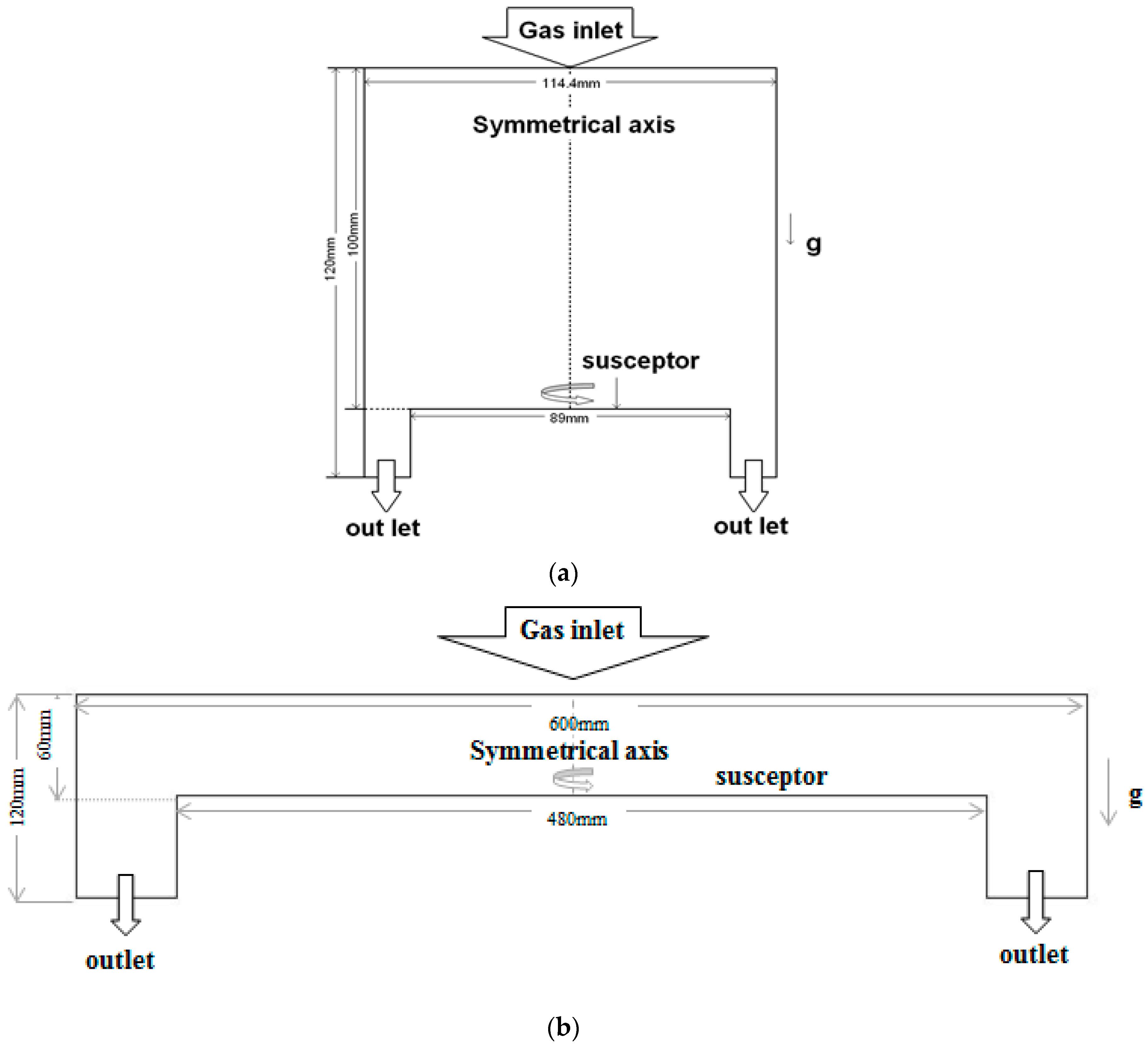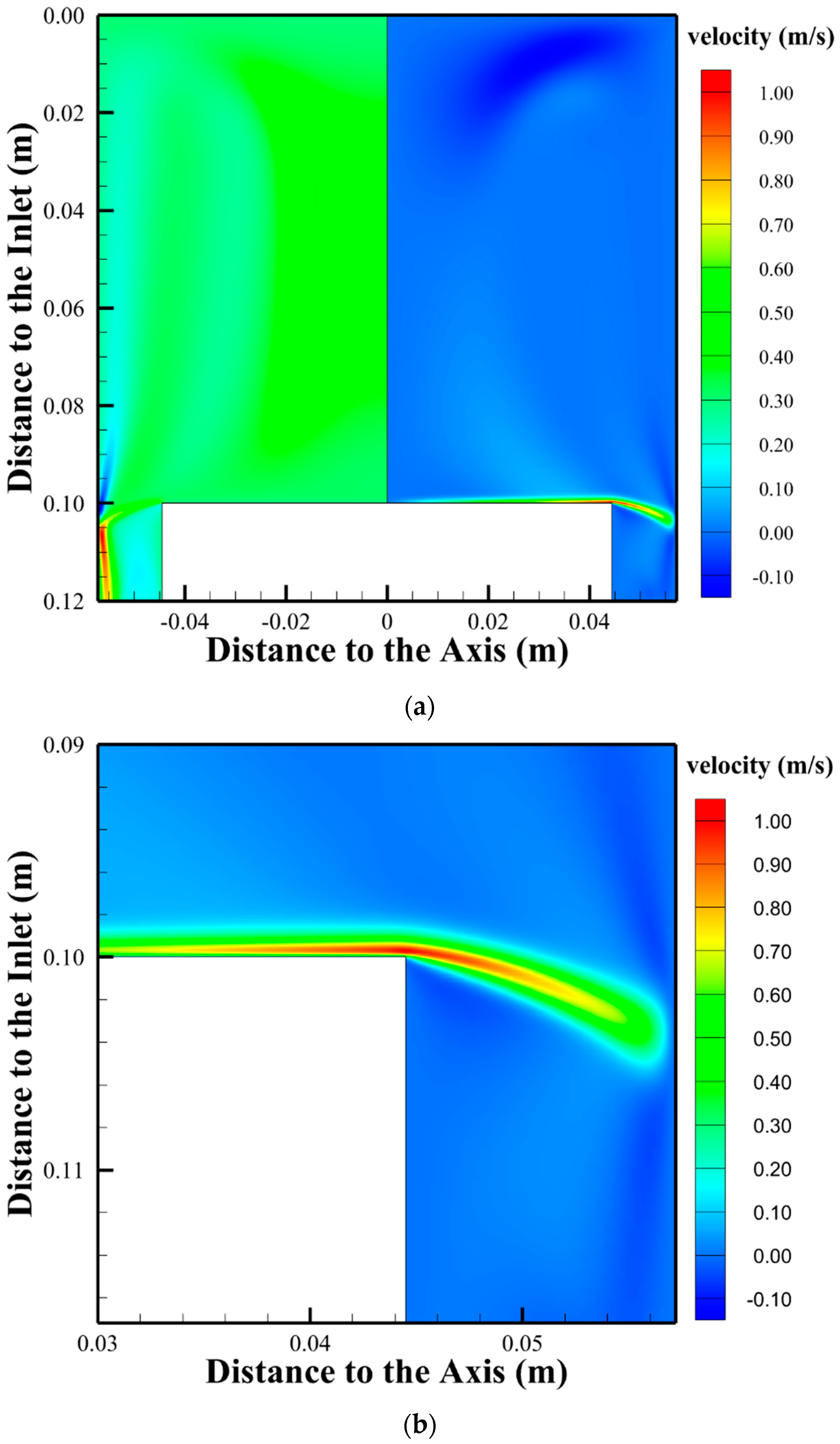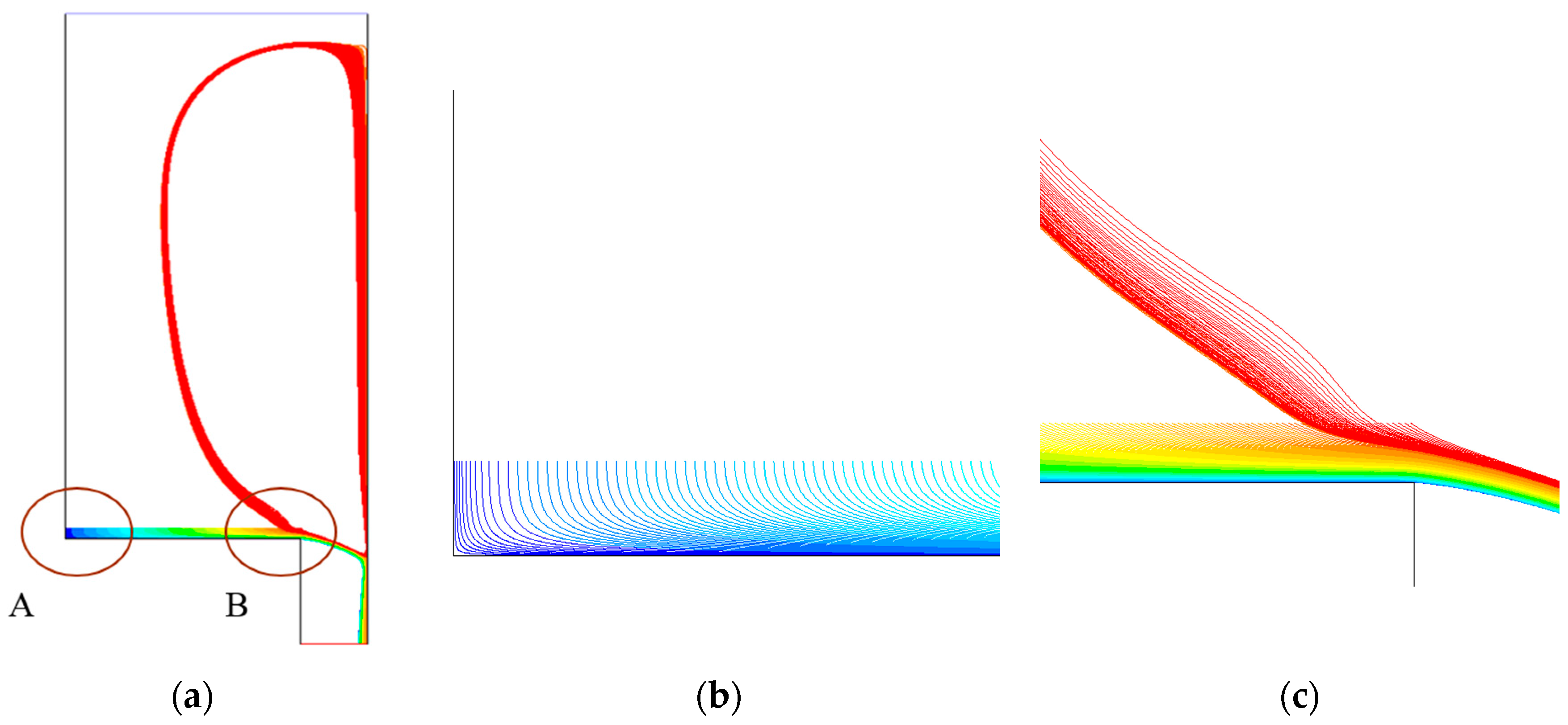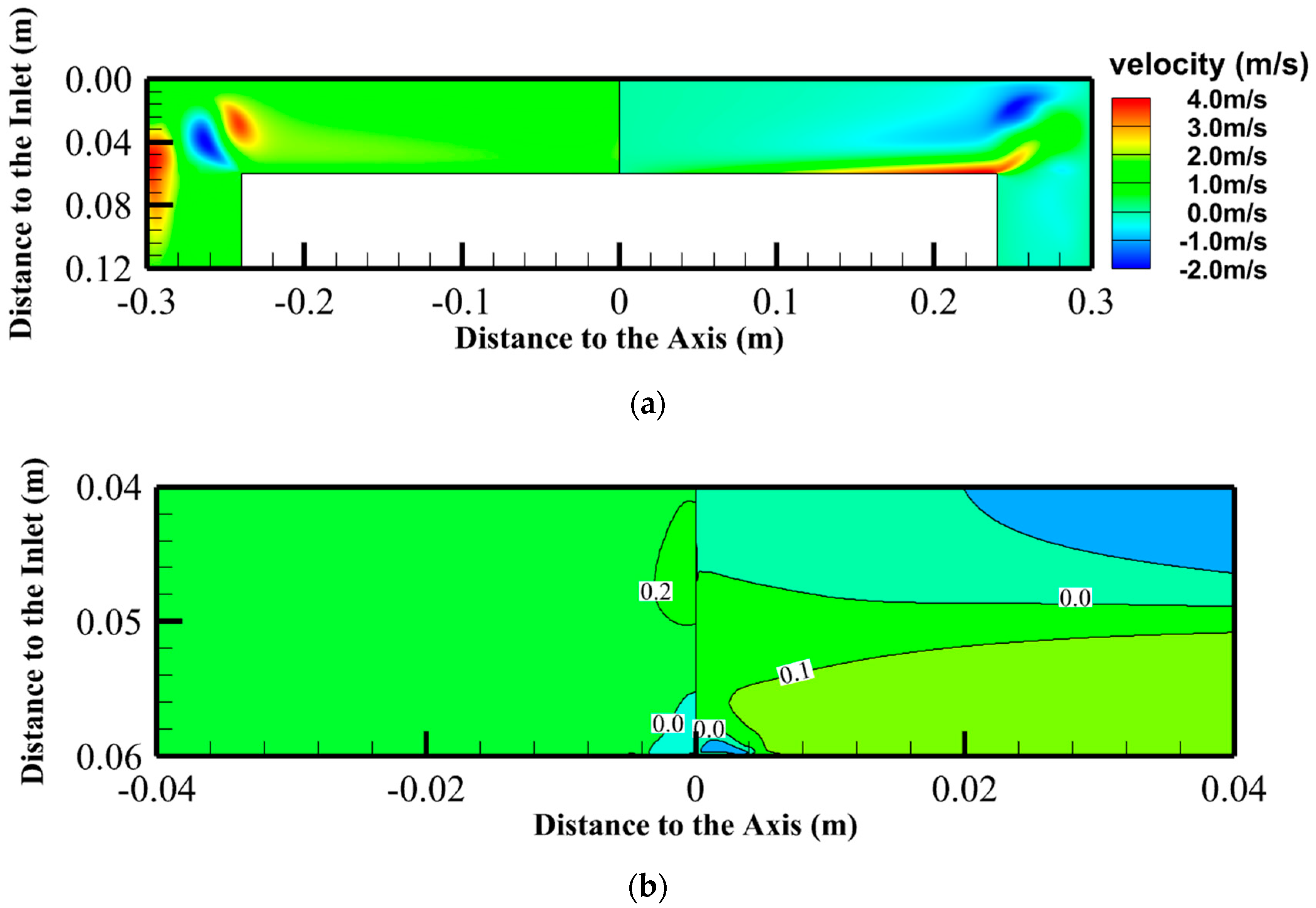Study on Motion and Deposition of Nanoparticles in Rotary MOCVD Reactors of Gallium Nitride
Abstract
:1. Introduction
2. Numerical Model
3. Results and Discussion
3.1. Single-Wafer Reactor
3.2. Multi-Wafer Reactor
4. Conclusions
Author Contributions
Funding
Data Availability Statement
Acknowledgments
Conflicts of Interest
References
- Taniyasu, Y.; Kasu, M.; Makimoto, T. An aluminium nitride light-emitting diode with a wavelength of 210 nanometres. Nature 2006, 441, 325–328. [Google Scholar] [CrossRef] [PubMed]
- Akasaki, I.; Amano, H. Crystal growth and conductivity control of group III nitride semiconductors and their application to short wavelength light emitters. Jpn. J. Appl. Phys. 1997, 36, 5393–5408. [Google Scholar] [CrossRef]
- Nakamura, S.; Senoh, M.; Iwasa, N.; Nagahama, S.; Yamada, T.; Mukai, T. Superbright green InGaN single-quantum-well-structure light-emitting diodes. Jpn. J. Appl. Phys. 1995, 34, L1332–L1335. [Google Scholar] [CrossRef]
- Zhao, D.G.; Zhu, J.J.; Jiang, D.S.; Yang, H.; Liang, J.W.; Li, X.Y.; Gong, H.M. Parasitic reaction and its effect on the growth rate of AlN by metalorganic chemical vapor deposition. J. Cryst. Growth 2006, 289, 72–75. [Google Scholar] [CrossRef]
- Chen, C.H.; Liu, H.; Steigerwald, D.; Imler, W.; Kuo, C.P.; Craford, M.G.; Ludowise, M.; Lster, S.; Amano, J. A study of parasitic reactions between NH3 and TMGa or TMAI. J. Electron. Mater. 1996, 25, 1004–1008. [Google Scholar] [CrossRef]
- Coltrin, M.E.; Creighton, J.R. Chemistry of AlGaN Particulate Formation; Research Briefs; National Nuclear Security Administration, Physical, Chemical, & Nano Sciences Center: Washington, DC, USA, 2005; pp. 42–43.
- Creighton, J.R.; Wang, G.T.; Breiland, W.G.; Coitrin, M.E. Nature of the parasitic chemistry during AlGaInN OMVPE. J. Cryst. Growth 2004, 261, 204–213. [Google Scholar] [CrossRef]
- Su, Z.; Kong, R.; Hu, X.; Song, Y.; Deng, Z.; Jiang, Y.; Li, Y.; Chen, H. Effect of initial condition on the quality of GaN film and AlGaN/GaN heterojunction grown on flat sapphire substrate with ex-situ sputtered AlN by MOCVD. Vacuum 2022, 201, 111063. [Google Scholar] [CrossRef]
- Moffat, H.; Jensen, K.F. Complex flow phenomena in MOCVD reactors: I. Horizontal reactors. J. Cryst. Growth 1986, 77, 108–119. [Google Scholar] [CrossRef]
- Dimitrios, I.; Kremer, A.M.; McKenna, D.R.; Jensen, K.F. Complex flow phenomena in vertical MOCVD reactors: Effects on deposition uniformity and interface abruptness. J. Cryst. Growth 1987, 85, 154–164. [Google Scholar]
- Li, J.; Wang, J.; Cai, J.D.; Xu, Y.F.; Fan, B.F.; Wang, G. Numerical simulation and analysis of process parameters of GaN-MOCVD reactor. Int. Commun. Heat Mass Transf. 2018, 91, 64–76. [Google Scholar] [CrossRef]
- Wang, J.; Li, J.; He, Y.C.; Luo, T.-C.; Li, Y.; Fan, B.-F.; Wang, G. High-speed flow field prediction and process parameters optimization in a vertical MOCVD reactor based on a hybrid RSM-KNN model. Int. Commun. Heat Mass Transf. 2021, 129, 105741. [Google Scholar] [CrossRef]
- Wang, J.; He, Y.C.; Luo, T.C.; Li, Y.; Zhou, Z.; Fan, B.F.; Wang, G. Simulation and experimental verification study on the process parameters of ZnO-MOCVD. Ceram. Int. 2021, 47, 15471–15482. [Google Scholar] [CrossRef]
- Wu, Y.Y.; Wu, R.; Zhou, X.S.; Wang, H.; Hu, Y.; Nie, D.; Bao, D. Numerical Modelling on the Effect of Temperature on MOCVD Growth of ZnO Using Diethylzinc and Tertiarybutanol. Coatings 2022, 12, 1991. [Google Scholar] [CrossRef]
- Lin, W.J.; Chen, J.C. A numerical study of the effect of pulse duration on preventing particle generation during the AlN pulsed MOCVD process. Mater. Sci. Semicon. Proc. 2022, 148, 106816. [Google Scholar] [CrossRef]
- Iliescu, L.; Gazal, Y.; Michau, A.; Addou, F.; Duguet, T.; Monsifrot, E.; Schuster, F.; Maury, F. Low temperature Direct Liquid Injection MOCVD of amorphous CrCx coatings in large-scale reactors: An original route to nanostructured multilayer coatings. Surf. Coat. Tech. 2021, 416, 127174. [Google Scholar] [CrossRef]
- Li, J.; Gan, H.L.; Xu, Y.F.; Wang, C.; Gu, F.L.; Wang, G. Chemical reaction-transport model of oxidized diethylzinc based on quantum mechanics and computational fluid dynamics approaches. Rsc. Adv. 2018, 8, 1116–1123. [Google Scholar] [CrossRef] [PubMed]
- Tang, L.; Zuo, R.; Zhang, H. Quantum chemical study on nanoparticles formation mechanism in AlGaN MOCVD growth. J. Cryst. Growth 2019, 525, 125201. [Google Scholar] [CrossRef]
- Liu, L.; Kakimoto, K. Partly three-dimensional global modeling of a silicon Czochralski furnace. I. Principles, formulation and implementation of the model. Int. J. Heat Mass Transf. 2005, 48, 4481–4491. [Google Scholar] [CrossRef]
- Breiland, W.G.; Coltrin, M.E.; Creighton, J.R.; Hou, H.Q.; Moffat, H.K.; Tsao, J.Y. Organometallic vapor phase epitaxy (OMVPE). Mater. Sci. Eng. R 1999, 24, 241–274. [Google Scholar] [CrossRef]
- Saffman, P.G.T. The lift on a small sphere in a slow shear flow. J. Fluid Mech. 1965, 22, 385–400. [Google Scholar] [CrossRef]
- Mazo, R.M. Brownian Motion: Fluctuations, Dynamics, and Applications, 1st ed.; OUP: Oxford, UK, 2008. [Google Scholar]
- Talbot, L.; Cheng, R.K.; Schefer, R.W.; Willis, D.R. Thermophoresis of particles in a heated boundary layer. J. Fluid Mech. 1980, 101, 737–758. [Google Scholar] [CrossRef]
- Haider, A.; Levenspiel, O. Drag coefficient and terminal velocity of spherical and nonspherical particles. Powder Technol. 1989, 58, 63–70. [Google Scholar] [CrossRef]
- Sommerfeld, M. Modelling of particle-wall collisions in confined gas-particle flows. Int. J. Multiph. Flow 1992, 18, 905–926. [Google Scholar] [CrossRef]
- Joseph, G.G.; Zenit, R.; Hunt, M.L.; Rosenwinkel, A.M. Particle–wall collisions in a viscous fluid. J. Fluid Mech. 2001, 433, 329–346. [Google Scholar] [CrossRef]
- Endres, D.; Mazumder, S. Brownian dynamics study of particles in chemical vapor deposition of aluminum nitride. Int. J. Heat Mass Transf. 2012, 55, 2714–2718. [Google Scholar] [CrossRef]









| Inside the Reactor | Escape | |||
|---|---|---|---|---|
| Deposition | Endless Movement | Inlet | Outlet | |
| Number of particles | 0 | 205 | 0 | 1995 |
| percentage | 0% | 9.3% | 0% | 90.7% |
| Rotating Speed rad/s | Particles | Inside the Reactor | Escape | ||
|---|---|---|---|---|---|
| Deposition | Endless Movement | Inlet | Outlet | ||
| 80 | Number | 0 | 0 | 0 | 2200 |
| percentage | 0% | 0% | 0% | 100% | |
| 100 | Number | 0 | 80 | 0 | 2120 |
| percentage | 0% | 3.6% | 0% | 96.4% | |
| 120 | Number | 0 | 205 | 0 | 1995 |
| percentage | 0% | 9.3% | 0% | 90.7% | |
| Deposited on S1 | Escape after Getting Entangled in a Vortex | Escape Directly from the Exit | |
|---|---|---|---|
| Number of particles | 40 | 707 | 1652 |
| percentage | 1.67% | 29.47% | 68.86% |
| Rotating Speed rad/s | Particles | Deposited on S1 | Escape after Getting Entangled in a Vortex | Escape Directly from the Exit |
|---|---|---|---|---|
| 80 | Number | 22 | 211 | 2166 |
| percentage | 0.92% | 8.79% | 90.29% | |
| 100 | Number | 30 | 530 | 1839 |
| percentage | 1.25% | 22.09% | 76.66% | |
| 120 | Number | 40 | 707 | 1652 |
| percentage | 1.67% | 29.47% | 68.86% |
Disclaimer/Publisher’s Note: The statements, opinions and data contained in all publications are solely those of the individual author(s) and contributor(s) and not of MDPI and/or the editor(s). MDPI and/or the editor(s) disclaim responsibility for any injury to people or property resulting from any ideas, methods, instructions or products referred to in the content. |
© 2023 by the authors. Licensee MDPI, Basel, Switzerland. This article is an open access article distributed under the terms and conditions of the Creative Commons Attribution (CC BY) license (https://creativecommons.org/licenses/by/4.0/).
Share and Cite
Su, P.; Lu, D.; Luo, J.; Zheng, G.; Sun, Y.; Liu, L. Study on Motion and Deposition of Nanoparticles in Rotary MOCVD Reactors of Gallium Nitride. Crystals 2023, 13, 1328. https://doi.org/10.3390/cryst13091328
Su P, Lu D, Luo J, Zheng G, Sun Y, Liu L. Study on Motion and Deposition of Nanoparticles in Rotary MOCVD Reactors of Gallium Nitride. Crystals. 2023; 13(9):1328. https://doi.org/10.3390/cryst13091328
Chicago/Turabian StyleSu, Peng, Daihui Lu, Jinping Luo, Guangyu Zheng, Yukang Sun, and Lijun Liu. 2023. "Study on Motion and Deposition of Nanoparticles in Rotary MOCVD Reactors of Gallium Nitride" Crystals 13, no. 9: 1328. https://doi.org/10.3390/cryst13091328
APA StyleSu, P., Lu, D., Luo, J., Zheng, G., Sun, Y., & Liu, L. (2023). Study on Motion and Deposition of Nanoparticles in Rotary MOCVD Reactors of Gallium Nitride. Crystals, 13(9), 1328. https://doi.org/10.3390/cryst13091328







